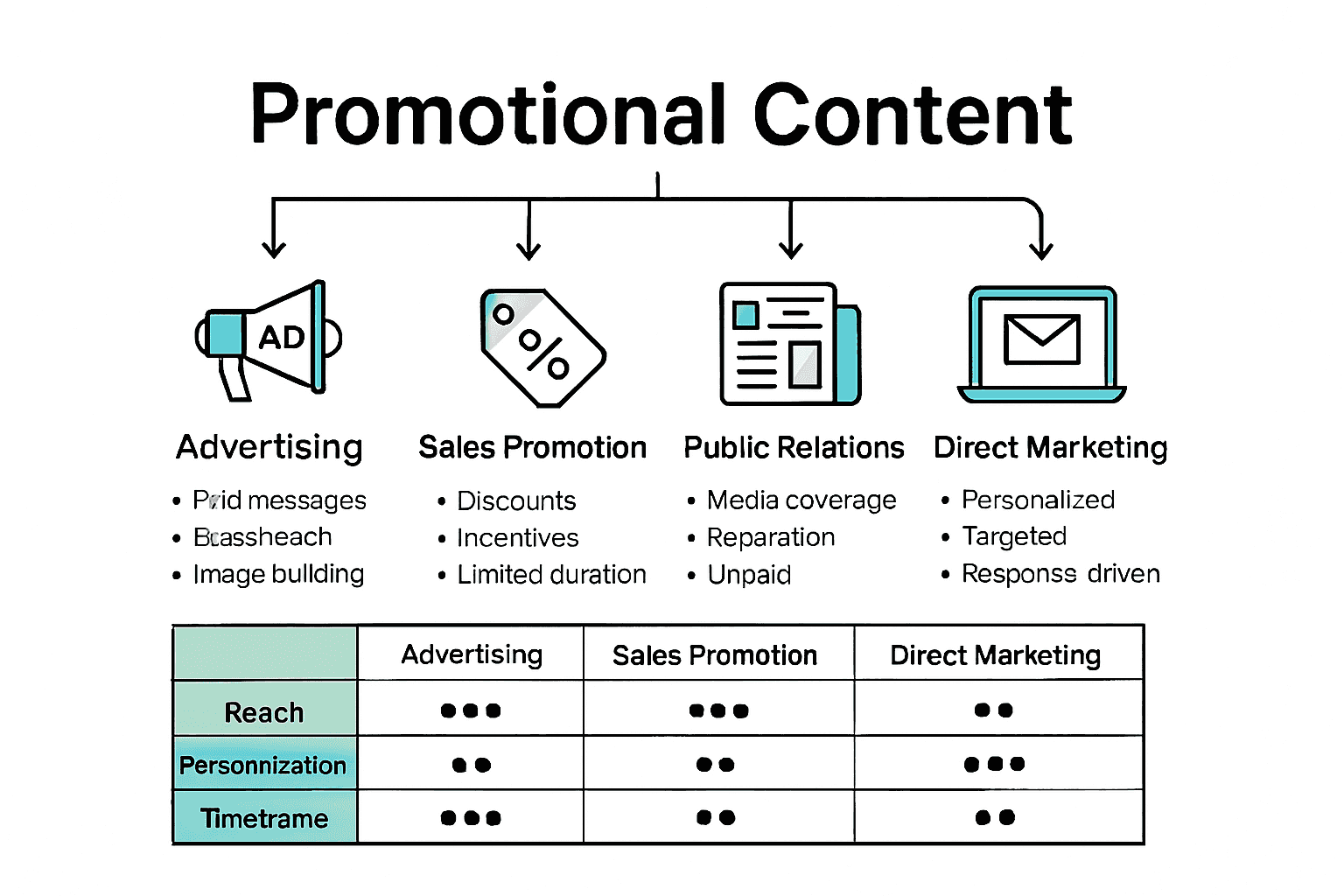Nearly every brand competes for attention, but only a few manage to leave a lasting impression through their promotional content. With companies investing billions in marketing, it becomes clear that thoughtful communication can make or break customer relationships. Understanding what defines effective promotional content and its real purpose helps businesses move beyond forgettable ads and create genuine connections that spark interest and drive real results.
Table of Contents
- Defining Promotional Content And Its Purpose
- Major Types Of Promotional Content Explained
- How Promotional Content Powers Affiliate Marketing
- Automated Creation Tools And Their Benefits
- Common Pitfalls And Mistakes To Avoid
Key Takeaways
| Point | Details |
|---|---|
| Strategic Purpose | Promotional content aims to inform, persuade, and engage customers, driving immediate action and fostering brand loyalty. |
| Diverse Types | Effective promotional content can take various forms, including advertising, sales promotions, public relations, and direct marketing, tailored to specific audience needs. |
| Affiliate Marketing Impact | Successful affiliate marketing relies on authentic promotional content that builds trust and connects products to consumer needs through storytelling. |
| Automation Benefits | Utilizing automated content creation tools enhances efficiency, ensures consistent messaging, and allows for personalized marketing at scale. |
Defining Promotional Content and Its Purpose
Promotional content represents strategic communication designed to introduce, market, and drive engagement with specific products, services, or brands. According to Coursera, promotional marketing involves sharing targeted information across multiple channels to enhance brand awareness and inspire customer action.
At its core, promotional content serves multiple interconnected objectives. As Marketing Decision explains, the fundamental purposes include informing potential customers, persuading them about product value, and ultimately influencing purchasing decisions. These communications aim to:
- Introduce new product offerings
- Develop positive brand perception
- Differentiate from competitive alternatives
- Foster customer loyalty
- Inspire immediate action
- Drive sales conversions
Successful promotional content requires a strategic approach that goes beyond simple advertising. It demands understanding your target audience’s motivations, crafting compelling narratives, and delivering value through informative and engaging messaging. The most effective promotional materials don’t just sell – they educate, entertain, and establish meaningful connections with potential customers.
Understanding these nuanced goals transforms promotional content from mere marketing noise into a powerful communication tool that can significantly impact business growth and customer relationships. By focusing on genuine value and targeted messaging, businesses can create promotional content that resonates deeply with their intended audience.
Major Types of Promotional Content Explained
Promotional content manifests in diverse formats, each designed to engage audiences and drive specific marketing objectives. According to GeeksforGeeks, the promotional mix comprises four fundamental categories: advertising, sales promotion, public relations, and direct marketing.
Advertising represents the most recognizable form of promotional content – a paid, non-personal communication method aimed at reaching broad audiences. This category includes:
- Digital banner ads
- Social media sponsored content
- Television and radio commercials
- Print magazine and newspaper advertisements
- Online video promotions
As Teach Me Business highlights, sales promotions offer more direct, short-term engagement strategies. These tactically designed initiatives include product samples, loyalty programs, promotional tie-ins, and visual merchandising techniques specifically crafted to encourage immediate purchasing decisions.
Public relations and direct marketing complete the promotional content spectrum. PR focuses on building positive brand relationships through press releases, media communications, and reputation management, while direct marketing creates personalized, one-to-one communication channels with potential customers through targeted email campaigns, personalized direct mail, and precision-targeted digital communications.
Understanding these promotional content types allows marketers to strategically select and combine approaches that resonate most effectively with their specific target audience and business goals.
 The key is not just selecting a promotional method, but crafting a nuanced, integrated strategy that speaks directly to customer needs and preferences.
The key is not just selecting a promotional method, but crafting a nuanced, integrated strategy that speaks directly to customer needs and preferences.

How Promotional Content Powers Affiliate Marketing
Affiliate marketing thrives on strategic promotional content that connects potential customers with valuable products and services. As Mass.gov highlights, digital advertising represents a powerful mechanism for reaching precisely targeted consumer segments most likely to engage with specific offerings.
Affiliate promotional content operates through several critical mechanisms:
- Creating compelling narratives around products
- Demonstrating real-world product benefits
- Building trust through authentic recommendations
- Providing detailed, value-driven information
- Addressing potential customer pain points
Successful affiliate marketers understand that promotional content isn’t about aggressive selling, but about crafting genuine connections. This means developing multi-dimensional content strategies that go beyond simple product descriptions. Effective approaches include comprehensive product reviews, comparative analyses, tutorial-style demonstrations, and personal storytelling that illustrates how a product solves real-world problems.
The digital landscape offers affiliate marketers unprecedented opportunities to create targeted, engaging promotional content. By leveraging platforms like blogs, YouTube, social media, and email marketing, affiliates can develop nuanced promotional strategies that speak directly to specific audience segments. The most successful promotional content doesn’t just highlight product features – it creates an emotional connection, showing potential customers how a product can transform their lives or solve critical challenges.
Ultimately, powerful promotional content in affiliate marketing is about building trust, providing genuine value, and creating meaningful connections between products and the people who need them most. By focusing on authenticity, detailed information, and audience-specific storytelling, affiliate marketers can transform promotional content from a sales pitch into a valuable resource that genuinely helps consumers make informed purchasing decisions.
Automated Creation Tools and Their Benefits
Automated promotional content creation tools represent a revolutionary approach to marketing efficiency. As CLRN explains, digital publication technologies now rely on sophisticated software infrastructure that enables unprecedented levels of content generation and multimedia integration.
Automated content creation tools offer marketers several transformative advantages:
- Rapid content production
- Consistent brand messaging
- Personalization at scale
- Reduced manual research time
- Cost-effective content strategies
- AI-powered creative insights
These tools leverage advanced artificial intelligence to streamline the content development process. According to RSIS International, digital promotional materials now utilize sophisticated framing techniques and interactive elements designed to create emotionally compelling brand experiences with minimal human intervention.
The most effective automated content creation tools go beyond simple text generation. They incorporate sophisticated algorithms that can analyze market trends, understand audience preferences, and generate contextually relevant promotional materials across multiple platforms. This means marketers can produce high-quality, targeted content that resonates with specific audience segments without spending countless hours on manual research and writing.
Ultimately, automated content creation represents more than a technological convenience – it’s a strategic approach to modern marketing. By embracing these tools, businesses can maintain consistent messaging, reduce operational costs, and deliver personalized experiences that connect meaningfully with their target audiences. The future of promotional content lies not in replacing human creativity, but in augmenting it through intelligent, adaptive technologies that understand nuanced communication strategies.
Common Pitfalls and Mistakes to Avoid
Promotional content can quickly become ineffective when marketers fall into common strategic traps. As Biz Libretexts highlights, public relations efforts can be particularly unpredictable, with success measured by media mentions that may not always align with the intended message.
Critical promotional content mistakes include:
- Overemphasizing product features instead of customer benefits
- Failing to understand target audience needs
- Creating generic, non-specific content
- Neglecting storytelling and emotional connection
- Inconsistent messaging across platforms
- Ignoring data and audience feedback
One of the most significant errors marketers make is treating promotional content as a one-size-fits-all solution. Each audience segment requires a nuanced approach that speaks directly to their unique pain points, aspirations, and communication preferences. This means moving beyond surface-level descriptions and developing deep, empathetic content that demonstrates genuine understanding of customer challenges.
Successful promotional content demands continuous refinement and adaptability. Marketers must remain vigilant about potential disconnects between their messaging and audience expectations. This involves regular performance analysis, audience feedback integration, and a willingness to pivot strategies when current approaches fail to generate meaningful engagement. The most effective promotional content creators view their work as an ongoing conversation, not a static communication method.
Ultimately, avoiding promotional content pitfalls requires a holistic approach that balances creativity, strategic thinking, and authentic audience connection. By prioritizing genuine value, maintaining consistent brand voice, and staying attuned to evolving market dynamics, marketers can develop promotional content that truly resonates and drives meaningful action.
Transform Your Promotional Content Strategy with Ease and Speed
The article highlights common challenges in creating promotional content such as wasting time on research, struggling to connect authentically with your audience, and crafting messages that truly resonate. If you find yourself overwhelmed by the complexity of delivering personalized, persuasive content that drives real engagement and sales, you are not alone. These pain points around consistency, emotional connection, and producing value-driven promotions are exactly what many affiliate marketers face daily.
You can overcome these hurdles without the stress and guesswork. PromoBlitz, featured at https://stevepritchardonline.store, is designed specifically for affiliate marketers, product promoters, and beginners who want to automate and simplify the entire process. This AI-powered Chrome extension instantly generates product summaries, email sequences, bonus ideas, landing pages, and even graphics without writing or complicated research. Imagine saving hours every day while delivering targeted, audience-specific promotional content that builds trust and inspires BUYING action.
Explore how PromoBlitz brings your promotional content to life with precision and emotional impact.

Ready to stop spinning your wheels and start creating promotional content that connects and converts? Visit PromoBlitz landing page now and see how you can automate your affiliate marketing efforts while maximizing your profits with true ease. Take the step toward more efficient marketing today.
Frequently Asked Questions
What is promotional content?
Promotional content refers to strategic communication designed to market and drive engagement with specific products, services, or brands. It aims to inform potential customers, persuade them about a product’s value, and influence purchasing decisions.
What are the major types of promotional content?
The major types include advertising (e.g., digital ads, commercials), sales promotions (e.g., loyalty programs, product samples), public relations (e.g., press releases, media communications), and direct marketing (e.g., email campaigns, personalized direct mail).
How can promotional content enhance affiliate marketing?
Promotional content enhances affiliate marketing by creating compelling narratives around products, demonstrating benefits, building trust through authentic recommendations, and addressing customer pain points. This helps forge connections between products and potential customers.
What are common mistakes to avoid when creating promotional content?
Common mistakes include overemphasizing product features instead of customer benefits, failing to understand the target audience, creating generic content, neglecting storytelling, inconsistent messaging, and ignoring data and audience feedback.